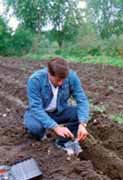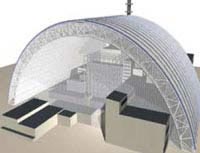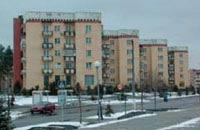



The authorities of the Soviet Union and, later, of the Commonwealth of Independent States (CIS) introduced many short and long term environmental countermeasures to deal with the consequences of the accident. This involved huge human, financial and scientific resources.
During the first years after the accident, settlements in contaminated regions of the USSR were cleaned up at great cost. However, this produced a disposal problem because it created a considerable amount of low-level radioactive waste.
Soon after the accident, the most effective agricultural countermeasures to avoid human exposure to radioactive iodine through milk were the use of "clean" fodder for cattle and rejection of contaminated milk. However, these early countermeasures were only partially effective because of the lack of timely information, particularly for private farmers.
In order to reduce long term contamination of milk and meat with radioactive caesium, the land used for fodder crops was treated and animals were given not only clean fodder but also chemicals that "trap" the radioactive caesium. These effective but costly countermeasures have been applied less often since the middle of the 1990s leading to increased levels of radioactive caesium in agricultural products.
Restrictions have also been applied to many forests of the former USSR and in Scandinavia, in terms of access, hunting, and harvesting of forest products such as berries, mushrooms, and firewood.
Many attempts were made to protect water systems from radioactive materials leaching from contaminated soils, but they were generally ineffective and expensive. The most effective countermeasure was switching to uncontaminated drinking water supplies. Restrictions on consumption of freshwater fish were only followed in some areas. More...

Between May and November 1986, a Shelter was built to contain the damaged reactor, reduce the radiation levels on-site, and prevent further release of radioactive material.
However, problems have later arisen from the fact that the Shelter had to be erected quickly and under very difficult conditions, partly because the construction personnel were exposed to severe radiation levels. Some structural parts have corroded during the past 20 years, which could potentially lead to the collapse of the Shelter and thus to the release of radioactive dust into the environment.
To avoid the top of the Shelter collapsing, there are plans to strengthen unstable structures and to build a New Safe Confinement (NSC) that would cover the existing Shelter and last more than 100 years. The NSC would allow workers to dismantle the current Shelter, remove highly radioactive material from the damaged reactor, and eventually dismantle it altogether.
After the accident, the cleaning operations created a large volume of radioactive waste and this was placed in trenches and land-fills in the Exclusion Zone that do not meet current waste safety requirements. In addition, no clear method of managing the existing high-level and long-lived radioactive waste has yet been developed. It is important that the new radioactive waste that will be generated by the upcoming construction work is disposed of properly. More...

The overall plan for the long term development of the Exclusion Zone is to make the less affected areas available for use by the public.
Because restrictions on food crops planting and cattle grazing apply to these areas, they are best suited for industrial use rather than for residential or agricultural purposes.
Industrial activities may include not only the construction of the New Safe Confinement and the decommissioning of the reactor, but also the processing and management of radioactive waste. Other potential activities include the development of natural reserves and environmental research. More...

This summary is free and ad-free, as is all of our content. You can help us remain free and independant as well as to develop new ways to communicate science by becoming a Patron!